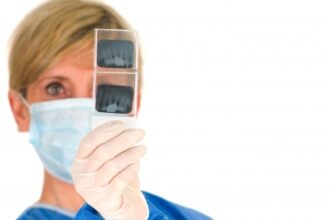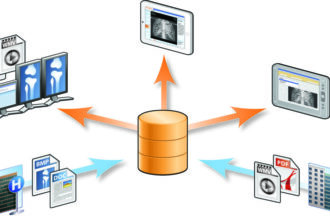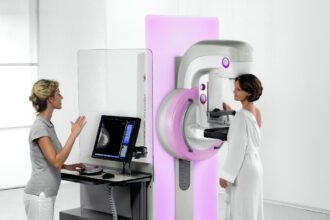
Jeremy Enfinger, BS, RT(R), Radiology Lead Tech at Scripps Health
Editor’s Note: We sat down with Jeremy Enfinger, BS, RT(R), Radiology Lead Tech at Scripps Health and Adjunct Radiography Instructor at San Diego Mesa College, to get his thoughts on the evolution of the radiography profession, digital x-ray technology and the importance of continuing education and networking.
Q: What impact is health reform having on radiographers and the radiology department?
A: Health reform is driving radiographers to learn how to get by with less, at least for those who are employed by healthcare systems with the foresight to start making changes and cost-cuts early. We are building staffing and productivity models to best practice examples, standardizing supplies and procedures, and consciously making effort to reduce waste. We see it as a preemptive strike to become more efficient, produce higher quality, and improve patient satisfaction so that when reform budget cuts occur, we will be able to survive.
Q: What advice do you have for radiographers to continue to improve quality and lower dose?
A: For veteran radiographers, I recommend staying current with technology. We can’t use the same methods to acquire those optimum images that we used to during the film/screen imaging days. Educate yourselves on digital technology. For newcomers in the field, listen to the veterans about lessons learned and keep an open mind toward the many changes that are coming our way with technology, dose documentation, and the never-ending efforts to maximize diagnostic quality of images. There are always improvements that can be made no matter how long you have practiced radiography.
Q: You use portable imaging systems often in your hospital. What are the biggest challenges of mobile x-ray?
A: The biggest challenge I see with mobile x-ray is getting help when positioning the image receptor behind the patient. Some floors have plenty of staff to assist, but with health reform on the way, expect to see less staff available to assist and more independent manipulation of the patients. I have seen this practice already starting to take its toll across the country, and I would go so far as to say that as a result, we are going to start seeing more work-related injuries.
Q: What’s your best piece of advice for a rad tech looking to boost their exam efficiency?
A: I recently did a blog post on exam efficiency. Keep it simple: Be open to new methods of performing your exams, and be willing to learn from the veterans who are already efficient. You can adopt any of their practices that may boost your efficiency while maintaining your own preferences.
Q: As an adjunct radiography program instructor, you value continuing education. What’s the one continuing education course that has had the most impact on your career and day-to-day work?
A: I attended a two-day workshop for educators on digital radiography at the University of North Carolina when I lived there. I was amazed at how of the much knowledge I knew for film/screen imaging systems changed for image production and radiation dose requirements with CR and DR imaging. I can’t begin to describe how often I see techs (who haven’t had any education in digital imaging) observe a “light” image on the monitor, and repeat an exposure by doubling their mAs when the exposure indicator is adequate. If you began your career working with film/screen systems, you need to fight every instinct you have to avoid this mistake. This course taught me that there can be multiple reasons for this error, and further investigation is required. It is important for those of us who understand the appropriate methods for successfully repeating an image like this to educate those who have not yet taken any continuing education courses for digital imaging, as well as to encourage them to pursue it further themselves.
Q: You’ve been blogging about radiology since 2007 and recently started the Topics In Radiology Facebook page and newsletter. What’s your perspective on social media in the radiology profession?
A: I have become a kind of social media addict. It can be either good or bad for the profession depending on how it is used. I find that my blog gets a lot of traffic from student radiographers. This is great because new questions and public interaction are what keep it fueled. The good part about the social media is that most people can get updated with the latest news and events. I even answer some student questions on my blog. Let’s face it… Radiography is a niche topic that can be difficult to find information on that is easily interpretable.
What seems to be the negative part of social media in the field is that many people get on Twitter or Facebook with their personal accounts, and start connecting with people at their hospital or clinical sites. This alone isn’t bad per se, but it has caused a whole new challenge for HIPAA compliance and interaction with coworkers outside the confines of the work place. It can be a great tool as long as we treat it with responsibility.
Q: Your Pet Peeves of Rad Department’s blog post was a really good look inside what radiographers deal with everyday. What five things do you like most about being a radiology technologist?
A: I love to interact with patients. That’s one thing that I miss about my current position as a lead. I spend more time on the phone than with patients it seems, but I do enjoy the opportunities I still have to provide patient care.
I also like the “artistic” aspect of radiography. If you follow everything you are taught in your training, you can produce a product you can be proud of. There can be so many variations from patient to patient, but a good technologist will have many tricks and techniques over the years to obtain optimum images on everyone coming into the x-ray room.
The field is also very flexible. It’s easy to learn more with additional modality training. You can also work just about any hours you would like to. There’s always something new to learn, and you rarely get tired of doing the same thing every day because every patient can be a different challenge to image.
I also like the technology. There’s just something cool about doing this. Once you have the skills, you can make it look easy while obtaining high quality images. There are always new tools and gadgets that are being trialed within a hospital and it can be fun to experiment with the impact on your images.
Finally, I love the camaraderie of the field. After a few short years, I genuinely feel like I know someone in every hospital for at least a 100 mile radius. It’s a very small world in radiography, and that world seems even smaller the more time you spend in the field.
Q: Let’s talk radiology humor – techs do have fun, right? What’s your favorite radiology pun?
A: We have to have some fun at work… I’m a sucker for cheesy jokes or phrases. Here are two of my favorite 1) Tech A: “These are my O.R. scrubs.” Tech B: “Oh are they?” (insert eyebrow raise). 2) “Don’t lie to x-ray techs… we can see right through you.”
You can follow Jeremy at the Bloggin Radiology blog, the Topics In Radiology Facebook page and on Twitter.







